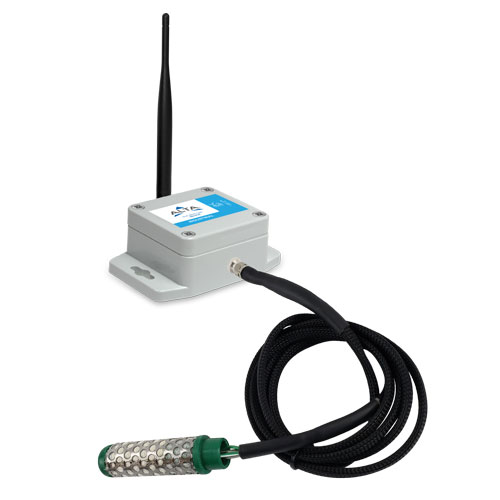How Soil Moisture Sensors Work
With a long-range, multi-frequency radio and flexible microcontroller, the ALTA® Soil Moisture Sensor tells you on a mobile device or computer how much, when, and where to water crops.
If water or temperature conditions deviate from preset parameters, you also get alerts on your mobile device via text, email, or call.

The two-in-one Soil Moisture Sensor features:
- A resistive granular matrix element to measure soil water tension (matric potential) in 0 to 240 centibar (cb) or kilopascal (kPa)
- A thermistor-based temperature element to assess soil temperature from -40°C to 125°C (-40°F to 257°F)

How the Soil Moisture Sensor Measures Soil Water Tension
The two elements of the Soil Moisture Sensor work together within a broad spectrum of different soil types, environments, and temperatures.
- The unique water tension element works as a root, measuring water tension in its hydrophilic fabric-covered matrix material rather than the surrounding soil.
- The water tension element also delivers consistent calibration without recalibrating it for every installation or measurement.
- The temperature element measures the soil moisture’s temperature compensation, so you don’t need to measure water every time the soil temperature changes.
Why Measure Soil Tension vs. Water Volume?
Many sensors measure basic volumetric water content in the soil. The Soil Moisture Sensor measures the more technically complex yet more valuable soil water tension or potential or, more specifically, matric water potential in its granular matrix. The measurement of soil water tension is recognized as the best indicator of soil water availability.
Sensors that only measure soil water volume can be limited because they can’t tell you how water moves. As an electrical resistance sensor that measures soil water tension, the Soil Moisture Sensor monitors the energy state of water that explains water movement, including the energy that a plant exerts to draw available water from the soil. When you measure water tension and temperature together, you can tell more accurately if your crops are healthy or stressed.
Key Features of the Soil Moisture Sensor that Help it Measure Soil Water Tension and Send Data
- Safe and durable in a variety of soils and both hot and freezing temperatures
- Corrosion-resistant and made of high-grade stainless steel
- Internally compensated for commonly found salinity levels
- Easy to install and use compared to traditional tensiometers
- Industry-leading wireless range of one mile at ground level, outdoors without obstructions
- Frequency-Hopping Spread Spectrum (FHSS) for greater signal interference tolerance
- Impairment immunity from physical obstructions, external wireless radio frequency systems, and electromagnetic interference (EMI)
- Encrypt-RF Security (Diffie-Hellman Key Exchange + AES-128 Cipher Blocker Chaining (CBC) for sensor data messages)
- Logs 2000 to 4000 readings if gateway connection is lost (non-volatile flash, persists through the power cycle): 10-minute heartbeats = ~22 days and 2-hour heartbeats = ~266 days
- Over-the-air (OTA) updates
- The iMonnit Online Wireless Sensor Monitoring and Notification System to configure the sensor, view data, and set alerts via SMS text and email
How the Soil Moisture Sensor Helps Take Care of Conservation Concerns
The Soil Moisture Sensor is engineered to solve water conservation and smart irrigation issues with the latest IoT and scientific measurement technologies. The sensor will help you water crops only when needed and avoid overwatering or underwatering them, improving water conservation.
Water monitoring using the Soil Moisture Sensor can help optimize precision irrigation scheduling in smart agriculture operations. By connecting soil water to the Internet of Things, the Soil Moisture Sensor triggers the effective and efficient use of irrigation water.
For more information about the ALTA Soil Moisture Sensor contact Monnit at info@monnit.com or call 801-561-5555.
Further Reading
How to Install the Soil Moisture Sensor
Soil Moisture Sensor Installation by Crop Type
Interpreting Soil Moisture Sensor Data